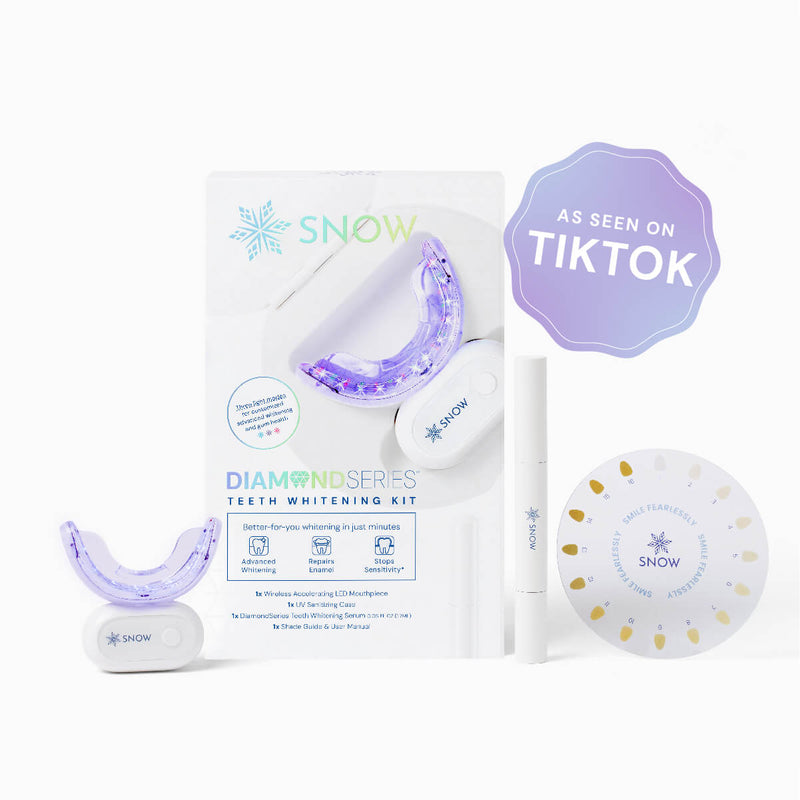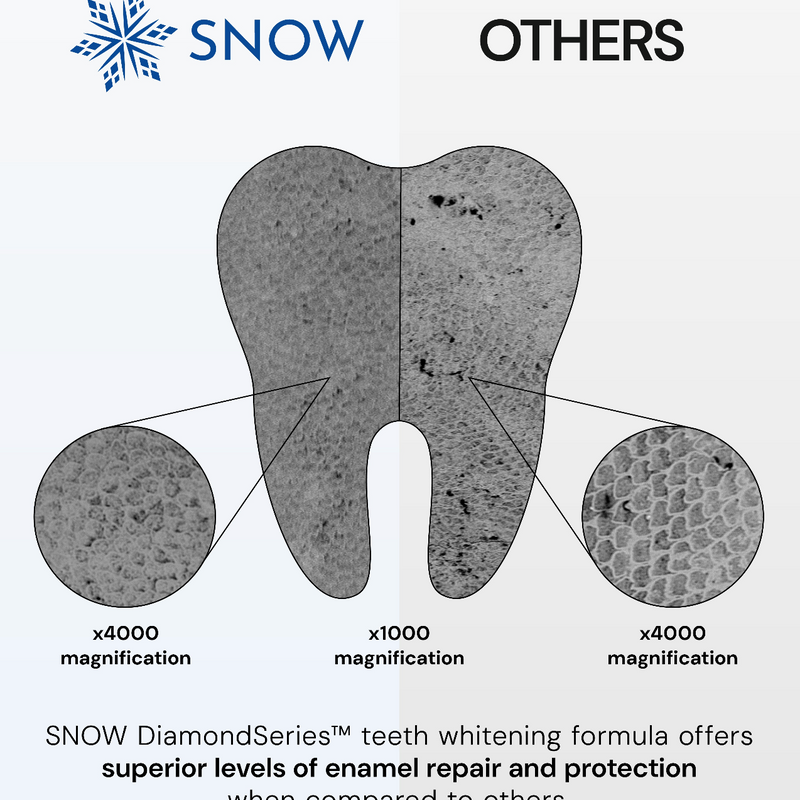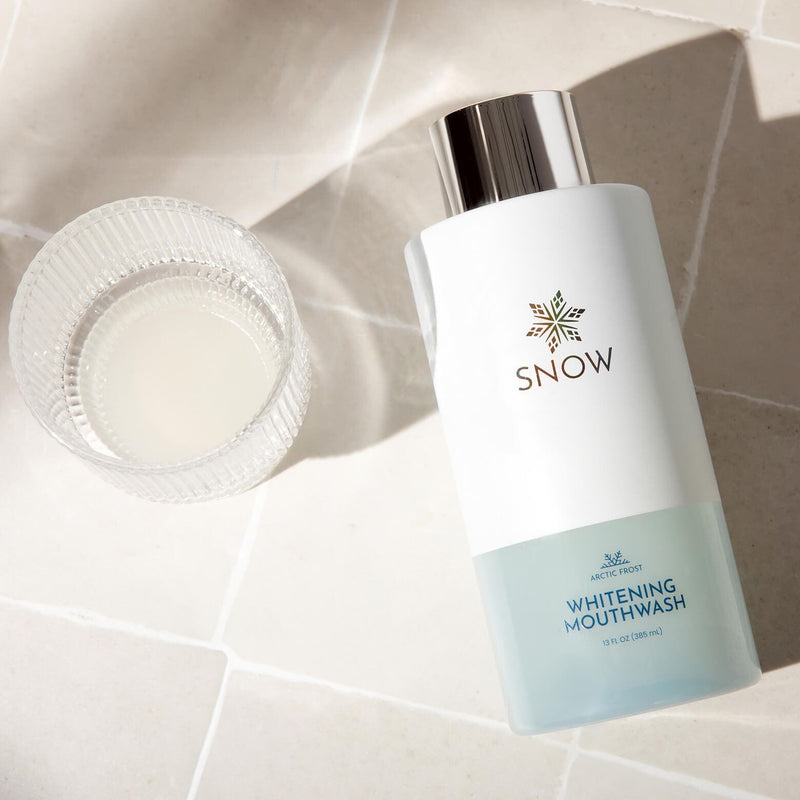Mold in electric toothbrushes can be a silent enemy, but fear not, we're here to shed light on this dental dilemma and provide actionable solutions to keep your toothbrush clean and safe.
As experts in dental health and advocates of at-home teeth-whitening, SNOW understands the importance of maintaining a healthy oral care routine.
Our primary goal is to empower you with knowledge and solutions to achieve a brighter, whiter smile while ensuring your dental hygiene remains impeccable.
What this article covers:- What's the Black Gunk on the Base of Your Electric Toothbrush?
- How Does Mold Grow on Toothbrushes?
- Can Mold on Your Toothbrush Make You Sick?
- How to Identify Mold on Your Toothbrush
- How Long Does It Take for Mold to Grow on a Toothbrush?
- How to Prevent a Moldy Electric Toothbrush
What's the Black Gunk on the Base of Your Electric Toothbrush?
That mysterious black gunk on the base of your electric toothbrush isn't just unsightly—it's likely mold. Mold thrives in damp environments, making your toothbrush base a perfect breeding ground. This buildup can harbor harmful bacteria and compromise your dental hygiene.
At SNOW, we prioritize dental health, and understanding the causes of mold growth is crucial. According to WebMD, moisture and lack of airflow contribute to mold formation.

When toothbrushes aren't allowed to dry properly between uses, mold can flourish.
Additionally, storing toothbrushes in closed containers or in damp environments exacerbates the problem.
To maintain optimal oral hygiene and prevent mold buildup, it's essential to clean your electric toothbrush regularly. SNOW recommends thoroughly rinsing the base and allowing it to air dry after each use.
By following proper cleaning practices, you can keep your toothbrush mold-free and safeguard your dental health.
How Does Mold Grow on Toothbrushes?
Mold growth on toothbrushes is facilitated by several factors inherent to bathroom environments and brushing habits. Here's a breakdown:
Warmth And Moisture
Mold flourishes in warm, damp conditions, creating an optimal habitat for growth on toothbrushes left in bathrooms.
Improper Storage
Inadequate airflow around toothbrushes, especially when stored in closed containers or in damp environments, promotes mold formation.
Infrequent Cleaning
Failing to rinse and dry toothbrushes properly after use allows moisture and residual toothpaste to accumulate, fostering mold proliferation.
Exposure To Bathroom Bacteria
Bathrooms harbor a multitude of bacteria, and when these microbes come into contact with toothbrushes, they contribute to the growth of mold and other pathogens.
Understanding these dynamics underscores the importance of implementing proper toothbrush hygiene practices to mitigate mold growth and maintain oral health.

Can Mold on Your Toothbrush Make You Sick?
Yes, mold on your toothbrush can potentially make you sick. Mold exposure can lead to respiratory issues, allergies, and other health concerns.
While the risk may be low, it's essential to maintain a clean toothbrush to minimize any potential health risks.
At SNOW, we prioritize your dental health and well-being. According to ScienceDirect, electric toothbrushes can harbor bacteria and mold if not cleaned properly.
Our LED Teeth Whitening Electric Toothbrush and Advanced Whitening Electric Toothbrush are designed to not only enhance your smile but also prioritize hygiene and cleanliness.
Regularly cleaning your toothbrush, allowing it to air dry between uses, and replacing it every three to four months are essential practices recommended by dental experts.
By incorporating these habits into your oral care routine, you can ensure a healthier mouth and minimize the risk of mold-related health issues.
How to Identify Mold on Your Toothbrush
Identifying mold on your toothbrush is essential for ensuring optimal oral hygiene. Look for black, green, or brown spots on the bristles or base of your toothbrush. These discolorations often indicate the presence of mold.
At SNOW, we understand the importance of maintaining a clean toothbrush to achieve a bright, healthy smile. Inspecting your toothbrush regularly for signs of mold growth, such as unusual texture or odor, is crucial for preventing potential health risks.
Furthermore,there are various mold species that can thrive in moist environments, including toothbrushes.
Our commitment to dental health emphasizes the need to address mold growth promptly to prevent potential health complications.
Regularly replacing your toothbrush head every three to four months and storing it in a dry, ventilated area can help prevent mold buildup.
By incorporating these practices into your oral care routine, you can maintain a clean toothbrush and promote excellent dental hygiene.

How Long Does It Take for Mold to Grow on a Toothbrush?
Mold growth on a toothbrush can occur surprisingly quickly if proper hygiene practices aren't followed.
In fact, mold can start to develop on a toothbrush within a short period, typically between 24 to 48 hours, especially if the toothbrush is not cleaned and stored correctly.
Understanding the rapid onset of mold growth underscores the importance of maintaining proper dental hygiene practices to safeguard against potential health risks associated with mold-contaminated toothbrushes.
How to Prevent a Moldy Electric Toothbrush
Maintaining a mold-free electric toothbrush is essential for effective oral hygiene. Follow these steps to prevent mold growth and ensure your toothbrush stays clean and hygienic:
- Thoroughly rinse it off after every use: After brushing, thoroughly rinse your toothbrush under running water to eliminate any toothpaste residue and food particles.
- Shake it: Shake your toothbrush vigorously to remove excess water and ensure it dries completely before storage.
- Store it like a pro: Store your toothbrush upright in a well-ventilated area to promote air circulation and prevent moisture buildup, which can lead to mold growth.
- Deep clean once a week: Regularly deep clean your toothbrush by soaking it in a solution of water and hydrogen peroxide to eliminate bacteria and mold spores.
- Replace the head on time: Replace your toothbrush head every three to four months, or sooner if the bristles show signs of wear, to maintain optimal cleaning effectiveness. Another awesome feature of our electric toothbrushes are the replacement brush heads!
- Create the best bathroom conditions: Keep your bathroom clean and dry to discourage mold growth. Consider using a dehumidifier to lower moisture levels and prevent mold formation.
Following these practices will help ensure that your electric toothbrush remains free from mold, contributing to better oral health and hygiene.
Conclusion
In the realm of dental hygiene, mold growth on toothbrushes poses a significant concern due to its rapid development in warm, moist environments.
Factors like improper storage and infrequent cleaning contribute to this issue.
Awareness and proactive measures are crucial to combatting this dental dilemma. By adopting proper cleaning habits and ensuring toothbrushes are stored in well-ventilated areas, individuals can mitigate mold growth risks effectively.
For those seeking optimal oral care, SNOW offers innovative LED Whitening Electric Toothbrushes, providing not only advanced cleaning but also a solution to maintain a bright smile. Explore SNOW's range for enhanced teeth whitening experiences.
If you found this article helpful, learn more from these related posts:
- Is an Electric Toothbrush Better
- When Should I Replace My Electric Toothbrush
- Should I Buy an Electric Toothbrush
- How Does a Vibrating Toothbrush Work
- Are Electric Toothbrushes Bad for Your Teeth
- Can You Use an Electric Toothbrush in the Shower
- How to Correctly Brush Your Teeth with an Electric Toothbrush
- What Are the Benefits of an Electric Toothbrush
- When Was the Toothbrush Invented?
- Types of Toothbrushes
- Types of Electric Toothbrush
- How Are Toothbrushes Made?
- Facts About Toothbrushes
- Evolution of Toothbrushes
- What Is the Best Toothbrush?























